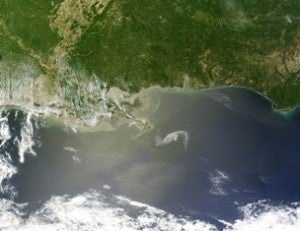Louisiana Oil Spill to Seriously Impact Marine Life and Fishing Communities in the Gulf; Federal Government Must Act Swiftly

The ocean ecosystems and fishing communities in the Gulf of Mexico face potentially catastrophic impacts as a result of the 5,000 barrels of oil a day spewing out of the sub-seabed and into the waters off the coast of Louisiana. Oil moving throughout vast expanses of Gulf waters and ocean habitat and coming ashore on the massive Gulf Coast wetlands directly threatens not just the reef fish, oysters, crabs and shrimp that actually live there, but also many other species that use the reefs, marshes and other wetlands as nurseries, or that depend upon them for prey which lives or develops there.
The beaches that are likely to be coated with oil also provide important feeding grounds for shorebirds and fish alike, and essential nesting areas for sea turtles. In addition, a large number of ocean species release larvae to drift with the currents in near-surface waters — exactly where the oil currently is — in their most vulnerable life stages.
Together, a huge fraction of the fish production in the region is at risk – a body blow both to marine ecosystems and the multi-billion dollar coastal industries tied to commercial fishing and seafood, and sport fisheries and recreation. It is especially sad that this catastrophe threatens the fishing communities of the Gulf that have become national leaders in transforming oceans fisheries to models of sustainability. EDF calls on the federal government to act swiftly to minimize preventable damage, but also with compassion to bring aid and assistance to already-reeling coastal communities.











One Comment
This should have never happened if there were proper permitting and monitoring guidelines. This rig was obviously not designed properly, did not have an adequate contingency plan (if any) and was inspected by the U.S. Mineral Management Service in Feb., March and April of this year with no violations noted. Obviously the current system does not work. It is imperative for any existing or future rigs that new guidelines be required. A campaign should be put forth immediately to allow no permits until it is shown that offshore rigs are engineered properly, have safety shutoff valves that are acessible and operational, and a full containment crew, well rehersed, is available immediately in the event of an accident. The monitoring system needs to be fixed as well. There are many of these rigs all along the U.S. coastline and this should never happen again, including the loss of worker lives.
Jim Knight